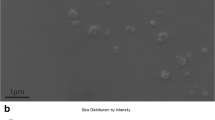Abstract
Purpose
This study aims at developing poly(ethylene oxide)-modified poly(epsilon-caprolactone) (PEO-PCL) nanoparticulate system as an intracellular delivery vehicle for saquinavir, an anti-HIV protease inhibitor.
Materials and Methods
Saquinavir-loaded PEO-PCL nanoparticles were prepared by a solvent displacement process. The formed nanoparticles were characterized for size, surface charge, and surface presence of PEO chains. Cellular uptake and distribution of the nanoparticle was examined in THP-1 human monocyte/macrophage (Mo/Mac) cell line. Intracellular saquinavir concentrations were measured as a function of dose and duration of incubation.
Results
The PEO-PCL nanoparticles had a smooth surface and spherical shape and showed a relatively uniform size distribution with a mean particle diameter of approximately 200 nm. The surface presence of PEO chains was confirmed by an increase in the –C–O–(ether) signature of the C1s spectra in electron spectroscopy for chemical analysis. Rapid cellular uptake of rhodamine-123 encapsulated PEO-PCL nanoparticles was observed in THP-1 cells. Intracellular saquinavir concentrations when administered in the nanoparticle formulation were significantly higher than from aqueous solution.
Conclusions
This study shows that PEO-PCL nanoparticles provide a versatile platform for encapsulation of saquinavir and subsequent intracellular delivery in Mo/Mac cells.




Similar content being viewed by others
References
X. Li and W. K. Chan. Transport, metabolism and elimination mechanisms of anti-HIV agents. Adv. Drug Deliv. Rev. 39:81–103 (1999).
K. Kedzierska and S. M. Crowe. The role of monocytes and macrophages in the pathogenesis of HIV-1 infection. Curr. Med. Chem. 9:1893–1903 (2002).
S. Gunaseelan, O. Deborah, L. Wan, M. J. Leibowitz, A. B. Rabson, S. Stein, and P. J. Sinko. Synthesis of poly(ethylene glycol)-based saquinavir prodrug conjugates and assessment of release and anti-HIV-1 bioactivity using novel protease inhibition assay. Bioconjug. Chem.15:1322–1333 (2004).
R. B. Kim. Drug transporters in HIV Therapy. Top HIV Med. 11:136–139 (2003).
S. A. Costas Kaparissides, K. Kotti, and S. Chaitidou. Recent advances in novel drug delivery systems. AZojono-Journal of Nanotechnology Online2:1–11 (2006).
R. A. Femia and R. E. Goyette. The science of megestrol acetate delivery: potential to improve outcomes in cachexia. BioDrugs19:179–187 (2005).
D. K. Sarker. Engineering of nanoemulsions for drug delivery. Curr. Drug. Deliv. 2:297–310 (2005).
J. Panyam and V. Labhasetwar. Targeting intracellular targets. Curr. Drug. Deliv. 1:235–247 (2004).
A. V. Kabanov and E. V. Batrakova. New technologies for drug delivery across the blood brain barrier. Curr. Pharm. Des. 10:1355–1363 (2004).
A. R. Bender, H. von Briesen, J. Kreuter, I. B. Duncan, and H. Rubsamen-Waigmann. Efficiency of nanoparticles as a carrier system for antiviral agents in human immunodeficiency virus-infected human monocytes/macrophages in vitro. Antimicrob. Agents Chemother. 40:1467–1471 (1996).
H. Boudad, P. Legrand, G. Lebas, M. Cheron, D. Duchene, and G. Ponchel. Combined hydroxypropyl-b-cyclodextrin and poly(alkylcyanoacrylate) nanoparticles intended for oral administration of saquinavir. Int. J. Pharm. 218:113–124 (2001).
S. Ponsart, J. Coudane, and M. Vert. A novel route to poly(epsilon-caprolactone)-based copolymers via anionic derivatization. Biomacromolecules1:275–281 (2000).
D. Lemoine, C. Francois, F. Kedzierewicz, V. Preat, M. Hoffman, and P. Maincent. Stability study of nanoparticles of poly (epsilon-caprolactone), poly(d,l-lactide) and poly(d,l-lactide-co-glycolide). Biomaterials17:2191–2197 (1996).
J. S. Chawla and M. M. Amiji. Biodegradable poly(epsilon-caprolactone) nanoparticles for tumor-targeted delivery of tamoxifen. Int. J. Pharm. 249:127–138 (2002).
D. B. Shenoy and M. M. Amiji. Poly(ethylene oxide)-modified poly(epsilon-caprolactone) nanoparticles for targeted delivery of tamoxifen in breast cancer. Int. J. Pharm. 293:261–270 (2005).
S. Noble and D. Faulds. Saquinavir. A review of its pharmacology and clinical potential in the management of HIV infection. Drugs52:93–112 (1996).
J. Batsis. Clinical pharmacology of protease inhibitors in HIV infection. Trinity Stud. Med. J. 1:60–65 (2000).
C. Flexner. Dual protease inhibitor therapy in HIV-infected patients: pharmacologic rationale and clinical benefits. Annu. Rev. Pharmacol. Toxicol. 40:649–674 (2000).
M. T. Huisman, J. W. Smit, H. R. Wiltshire, R. M. Hoetelmans, J. H. Beijnen, and A. H. Schinkel. P-glycoprotein limits oral availability, brain, and fetal penetration of saquinavir even with high doses of ritonavir. Mol. Pharmacol. 59:806–813 (2001).
A. Bender, A. Immelmann, J. Kreuter, H. Rubsamen-Waigmann, and H. von Briesen. Nanoparticles as drug carriers for antiviral agents against HIV. Int. Conf. AIDS11:64 (1996).
F. Gimenez, C. Fernandez, and A. Mabondzo. Transport of HIV protease inhibitors through the blood–brain barrier and interactions with the efflux proteins, P-glycoprotein and multidrug resistance proteins. J. Acquir. Immune Defic. Syndr. 36:649–658 (2004).
A. Janoly, N. Bleyzac, P. Favetta, M. C. Gagneu, Y. Bourhis, S. Coudray, I. Oger, and G. Aulagner. Simple and rapid high-performance liquid chromatographic method for nelfinavir, M8 nelfinavir metabolite, ritonavir and saquinavir assay in plasma. J. Chromatogr. B, Analyt. Technol. Biomed. Life Sci. 780:155–160 (2002).
S. Tsuchiya, M. Yamabe, Y. Yamaguchi, Y. Kobayashi, T. Konno, and K. Tada. Establishment and characterization of a human acute monocytic leukemia cell line (THP-1). Int. J. Cancer 26:171–176 (1980).
J. S. Chawla and M. M. Amiji. Cellular uptake and concentrations of tamoxifen upon administration in poly (epsilon-caprolactone) nanoparticles. AAPS PharmSciTech 5:E3 (2003).
X. Huang and C. S. Brazel. On the importance and mechanisms of burst release in matrix-controlled drug delivery systems. J. Control. Release73:121–136 (2001).
Acknowledgments
The authors thank Professor Robert Campbell for the access to particle size and zeta potential instrument and Ms. Sushma Kommareddy for the SEM analysis. Additionally, Dr. Lara Gamble’s help with the ESCA investigations at the NESAC/BIO is gratefully acknowledged. NESAC/BIO is supported by the National Institutes of Health grant EB-002027.
Author information
Authors and Affiliations
Corresponding author
Rights and permissions
About this article
Cite this article
Shah, L.K., Amiji, M.M. Intracellular Delivery of Saquinavir in Biodegradable Polymeric Nanoparticles for HIV/AIDS. Pharm Res 23, 2638–2645 (2006). https://doi.org/10.1007/s11095-006-9101-7
Received:
Accepted:
Published:
Issue Date:
DOI: https://doi.org/10.1007/s11095-006-9101-7




